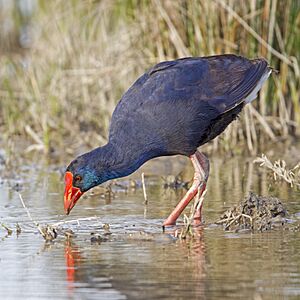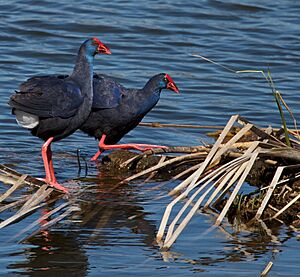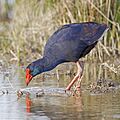Western swamphen facts for kids
Quick facts for kids Western swamphen |
|
|---|---|
 |
|
| On the island of Mallorca, Spain | |
| Conservation status | |
| Scientific classification | |
| Synonyms | |
|
The western swamphen (Porphyrio porphyrio) is a colorful bird that lives in wetlands. It belongs to the rail family, just like coots and moorhens. This bird is about the size of a chicken. It has big feet, bright feathers, and a red beak with a red shield on its forehead. These features make it easy to spot!
People sometimes call it the sultana bird. This name comes from its French name, talève sultane. The western swamphen used to be thought of as a type of purple swamphen. But now, scientists know it is its own separate species. You can find these birds in wet areas across Spain, Portugal, parts of France and Italy, and northwestern Africa. Spain has the largest number of western swamphens.
Contents
About Western Swamphens
Western swamphens make loud, quick calls. They sound like bleats and hoots, not like typical bird songs. They are especially noisy when they are breeding. Even though they might look a bit clumsy when flying, they can actually fly long distances. They are also very good swimmers, which is amazing because they don't have webbed feet!
Reproduction and Life Cycle
Western swamphens usually breed at certain times of the year. This often happens when there is a lot of rain, or during summer in cooler places. They build their nests in warm areas with lots of reeds. They often stay with one partner for breeding.
Their nests are big pads made from woven reeds and other plant bits. They build them on floating plants or in thick reeds just above the water. Each female bird can lay 3 to 6 eggs. The eggs are pale yellowish or reddish with brown spots. Both parents take turns sitting on the eggs for about 23 to 27 days.
When the chicks hatch, they are covered in soft black feathers. They can leave the nest soon after hatching, but they often stay for a few days. Their parents, and sometimes other group members, feed the young chicks for 10 to 14 days. After that, the chicks start to find their own food.
What They Eat
Western swamphens love wet places with lots of rain, like swamps, lake edges, and damp fields. They often live in pairs or in larger groups. They move through the reeds, eating soft plant shoots and other plant material. They have also been seen eating eggs, small ducklings, tiny fish, and invertebrates like snails. Sometimes, they even attack large eels! However, scientists are not sure if they actually eat the eels.
These birds often use one foot to bring food up to their mouth instead of eating it off the ground. If people don't bother them, western swamphens can become quite friendly. You might even see them in towns and cities.
Western Swamphens and People
In Ancient Times
People in ancient Greece and ancient Rome often kept swamphens. Writers like Aristotle described how these birds behaved. They were also mentioned by other famous people from that time. The birds kept were usually western swamphens or grey-headed swamphens. People didn't usually keep them for food. Instead, they were decorative birds in fancy homes and temples. If raised by humans, swamphens can become very tame.
You can see many pictures of western swamphens in old Roman mosaics and paintings. They are often shown in natural settings or in gardens. In early Christian art, they were also shown. Here, they often represented the richness of life and were sometimes seen sitting in the tree of life.
Protecting the Species
Today, the western swamphen is common in some areas. Spain has the largest population. It used to be listed as "Rare" in Europe, but now it's considered "Localised," which means it's found in specific areas.
The number of western swamphens dropped a lot in the early 1900s. This happened because their homes were destroyed and because of hunting. By the 1960s, they were seriously threatened. In Spain, they were only found in a few places.
But thanks to efforts to bring them back and protect their homes, the western swamphen population has grown. By the 1990s, they were common in many places. By 2000, their numbers in Spain were similar to what they were in 1900. From Spain, they have even spread into southeastern France. They are still rare in Portugal, but their numbers there are also getting better.
The western swamphen disappeared from Sicily in 1957. Now, in Italy, they are mainly found in Sardinia. But since 2000, people have been reintroducing them to Sicily. There is also a small group of "purple swamphens" in central Italy. These are actually grey-headed swamphens that escaped from a zoo.
We don't know much about western swamphens in Africa. But northeastern Algeria is thought to be a strong area for them there. When protected, western swamphens can live well in places managed by humans. In some areas, they live in paddy fields (rice fields). This can cause problems for farmers because the birds can damage the rice crops.
Images for kids





